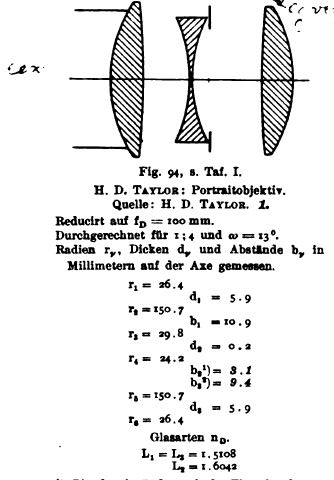Cooke Triplet on:
[Wikipedia]
[Google]
[Amazon]
The Cooke triplet is a
 A Cooke triplet comprises a negative flint glass element in the centre with a crown glass element on each side. In this design, the sum of all the curvatures times indices of refraction can be zero, so that the field of focus is flat (zero Petzval field curvature). In other words, the negative lens can be as strong as the outer two combined, when one measures in dioptres, yet the lens will converge light, because the rays strike the middle element close to the optical axis. The curvature of field is determined by the sum of the dioptres, but the focal length is not.
At the time, the Cooke triplet was a major advancement in lens design. It was superseded by later designs in high-end
A Cooke triplet comprises a negative flint glass element in the centre with a crown glass element on each side. In this design, the sum of all the curvatures times indices of refraction can be zero, so that the field of focus is flat (zero Petzval field curvature). In other words, the negative lens can be as strong as the outer two combined, when one measures in dioptres, yet the lens will converge light, because the rays strike the middle element close to the optical axis. The curvature of field is determined by the sum of the dioptres, but the focal length is not.
At the time, the Cooke triplet was a major advancement in lens design. It was superseded by later designs in high-end
Image: Rollei B 35 black.jpg, ''Triotar''-Triplet on a The Cooke triplet has provided the basis for additional designs, including a derivative with five lens elements.
Explanation of triplets from Fundamental Optical Design
Photographic lens designs
photographic lens
A camera lens (also known as photographic lens or photographic objective) is an optical lens or assembly of lenses used in conjunction with a camera body and mechanism to make images of objects either on photographic film or on other media capa ...
designed and patent
A patent is a type of intellectual property that gives its owner the legal right to exclude others from making, using, or selling an invention for a limited period of time in exchange for publishing an sufficiency of disclosure, enabling disclo ...
ed (patent number GB 22,607) in 1893 by Dennis Taylor who was employed as chief engineer by T. Cooke & Sons of York. It was the first lens system that allowed elimination of most of the optical distortion or aberration at the outer edge of the image.
The Cooke triplet is noted for being able to correct the Seidel aberrations. It is recognized as one of the most important objective designs in the field of photography.
The lens designed, invented by Dennis Taylor but named for the firm he worked for, consists of three separated lens elements. It has two biconvex lenses on the outer and a biconcave lens in the middle.
The design took a new approach to solving the optical design issues, and the design was presented to the Optical Society of London.
Design
camera
A camera is an optical instrument that can capture an image. Most cameras can capture 2D images, with some more advanced models being able to capture 3D images. At a basic level, most cameras consist of sealed boxes (the camera body), with a ...
s, but is still widely used in inexpensive cameras, including variations using aspheric elements, particularly in cell-phone cameras.
The Cooke triplet can correct, with only three elements, for one wavelength, spherical aberration, coma
A coma is a deep state of prolonged unconsciousness in which a person cannot be awakened, fails to respond normally to painful stimuli, light, or sound, lacks a normal wake-sleep cycle and does not initiate voluntary actions. Coma patients exhi ...
, astigmatism
Astigmatism is a type of refractive error due to rotational asymmetry in the eye's refractive power. This results in distorted or blurred vision at any distance. Other symptoms can include eyestrain, headaches, and trouble driving at ni ...
, field curvature, and distortion.
Application
The triplet soon became a standard in lens design still used with low-end cameras today. The main optical manufacturers often further developed the original Cooke triplet (e.g., the Zeiss Triotar) that were produced for many decades.Binoculars
Binoculars or field glasses are two refracting telescopes mounted side-by-side and aligned to point in the same direction, allowing the viewer to use both eyes ( binocular vision) when viewing distant objects. Most binoculars are sized to be hel ...
as well as refracting telescopes often use triplets. The same holds for many projection lenses, e.g., for 35 mm slide projector
A slide projector is an opto-mechanical device for showing photographic slides.
35 mm slide projectors, direct descendants of the larger-format magic lantern, first came into widespread use during the 1950s as a form of occasional home ...
s.
Rollei
Rollei () was a German manufacturer of optical instruments founded in 1920 by and in Braunschweig, Lower Saxony, and maker of the Rolleiflex and Rolleicord series of cameras. Later products included specialty and nostalgic type films for th ...
scale-focus camera
Image: Ed LiesegangPatrinast1-28 85 d37 zebra top.jpg, Projection objective ''Patrinast'' for a 35 mm slide projector by Ed. Liesegang; 1:2.8/85
Image: Will-Wetzlar-Maginon 1-2.8 100 d42Obl.jpg, Projection objective ''Maginon'' by Wilhelm Will, Wetzlar, 1:2.8/100
See also
* Achromatic lens *Chromatic aberration
In optics, chromatic aberration (CA), also called chromatic distortion and spherochromatism, is a failure of a lens to focus all colors to the same point. It is caused by dispersion: the refractive index of the lens elements varies with the ...
* Triplet lens
References
{{ReflistExternal links
Explanation of triplets from Fundamental Optical Design
Photographic lens designs